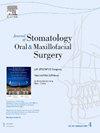The effect of local applications of hyaluronic acid gels on post-operative pain, trismus and soft tissue edema following third molar extraction: A systematic review
IF 2
3区 医学
Q2 DENTISTRY, ORAL SURGERY & MEDICINE
Journal of Stomatology Oral and Maxillofacial Surgery
Pub Date : 2025-10-01
DOI:10.1016/j.jormas.2025.102481
引用次数: 0
Abstract
Objective
Third molar extraction is a common surgical procedure, often resulting in postoperative pain, trismus, and swelling. Hyaluronic acid (HA) is a naturally occurring biopolymer with wound-healing and anti-inflammatory properties. Due to these characteristics, HA may offer clinical benefits when applied after tooth extraction. This study aims to systematically review the literature to evaluate the effects of HA gel application on postoperative pain, trismus, and soft tissue edema following third molar extraction.
Methods
A systematic literature review followed the PRISMA guidelines. An electronic search was performed in the PubMed, ScienceDirect, and Scopus databases using keywords: ‘hyaluronic acid’ OR ‘hyaluronan’ AND ‘gel’ AND ‘extraction’. Inclusion criteria were studies published in 2019–2024, in English, with full-text access, and randomized controlled trials (RCTs). Publications involved patients who underwent third molar extraction and assessed the effects of HA application on postoperative pain, trismus, and/or soft tissue edema compared to a control group.
Results
1183 articles were identified, 1163 screened after removing duplicates, and 10 publications selected for analysis after applying inclusion criteria.
Conclusions
Local application of HA gel following third molar extraction appears to contribute to postoperative pain reduction; however, its effectiveness in managing trismus and soft tissue edema remains inconclusive. Due to high methodological heterogeneity and risk of bias in the included studies, the overall robustness of the results is limited. Further well-designed, large-scale, and homogeneous clinical trials and systematic reviews are necessary to confirm the therapeutic benefits of HA gel in oral surgery.
透明质酸凝胶局部应用对第三磨牙拔牙术后疼痛、牙关紧闭和软组织水肿的影响:系统综述。
目的:第三磨牙拔除是一种常见的外科手术,经常导致术后疼痛、牙关紧闭和肿胀。透明质酸(HA)是一种天然存在的生物聚合物,具有伤口愈合和抗炎特性。由于这些特点,在拔牙后应用透明质酸可能会有临床益处。本研究旨在系统回顾文献,评价透明质酸凝胶应用对第三磨牙拔牙术后疼痛、牙关紧闭和软组织水肿的影响。方法:按照PRISMA指南进行系统的文献综述。在PubMed、ScienceDirect和Scopus数据库中使用关键词“透明质酸”或“透明质酸”、“凝胶”和“萃取物”进行电子检索。纳入标准为发表于2019-2024年的英文研究,有全文可查,随机对照试验(RCTs)。发表的文章涉及了接受第三磨牙拔牙的患者,并评估了与对照组相比,HA应用对术后疼痛、牙关紧闭和/或软组织水肿的影响。结果:共鉴定出1183篇文献,剔除重复后筛选出1163篇,应用纳入标准后选择10篇文献进行分析。结论:第三磨牙拔除后局部应用透明质酸凝胶有助于减轻术后疼痛;然而,其治疗牙关和软组织水肿的有效性仍不确定。由于纳入研究的方法学异质性和偏倚风险较高,结果的总体稳健性受到限制。需要进一步精心设计、大规模、均匀的临床试验和系统评价来证实透明质酸凝胶在口腔手术中的治疗效果。
本文章由计算机程序翻译,如有差异,请以英文原文为准。
求助全文
约1分钟内获得全文
求助全文
来源期刊

Journal of Stomatology Oral and Maxillofacial Surgery
Surgery, Dentistry, Oral Surgery and Medicine, Otorhinolaryngology and Facial Plastic Surgery
CiteScore
2.30
自引率
9.10%
发文量
0
审稿时长
23 days
 求助内容:
求助内容: 应助结果提醒方式:
应助结果提醒方式:


